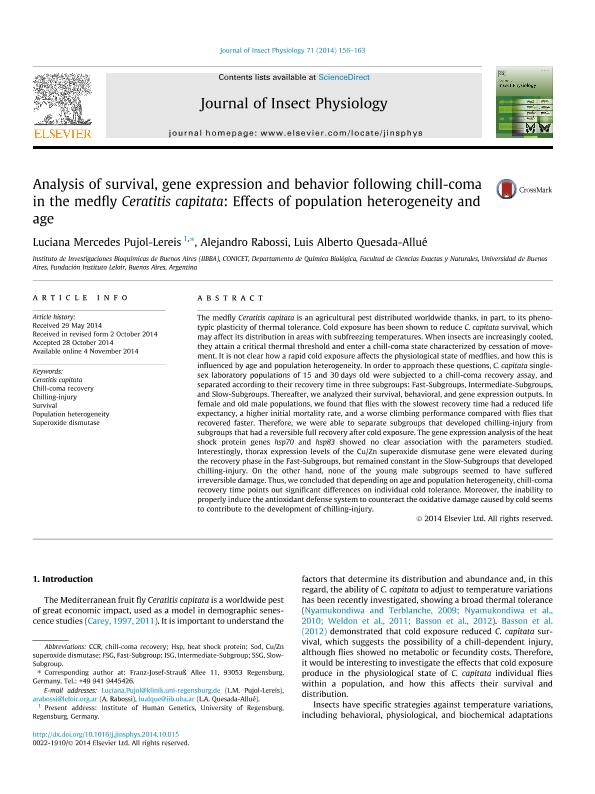Artículo
Analysis of survival, gene expression and behavior following chill-coma in the medfly Ceratitis capitata: effects of population heterogeneity and age
Fecha de publicación:
12/2014
Editorial:
Elsevier
Revista:
Journal of Insect Physiology
ISSN:
0022-1910
e-ISSN:
1879-1611
Idioma:
Inglés
Tipo de recurso:
Artículo publicado
Clasificación temática:
Resumen
The medfly Ceratitis capitata is an agricultural pest distributed worldwide thanks, in part, to its phenotypic plasticity of thermal tolerance. Cold exposure has been shown to reduce C. capitata survival, which may affect its distribution in areas with subfreezing temperatures. When insects are increasingly cooled, they attain a critical thermal threshold and enter a chill-coma state characterized by cessation of movement. It is not clear how a rapid cold exposure affects the physiological state of medflies, and how this is influenced by age and population heterogeneity. In order to approach these questions, C. capitata single-sex laboratory populations of 15 and 30 days old were subjected to a chill-coma recovery assay, and separated according to their recovery time in three subgroups: Fast-Subgroups, Intermediate-Subgroups, and Slow-Subgroups. Thereafter, we analyzed their survival, behavioral, and gene expression outputs. In female and old male populations, we found that flies with the slowest recovery time had a reduced life expectancy, a higher initial mortality rate, and a worse climbing performance compared with flies that recovered faster. Therefore, we were able to separate subgroups that developed chilling-injury from subgroups that had a reversible full recovery after cold exposure. The gene expression analysis of the heat shock protein genes hsp70 and hsp83 showed no clear association with the parameters studied. Interestingly, thorax expression levels of the Cu/Zn superoxide dismutase gene were elevated during the recovery phase in the Fast-Subgroups, but remained constant in the Slow-Subgroups that developed chilling-injury. On the other hand, none of the young male subgroups seemed to have suffered irreversible damage. Thus, we concluded that depending on age and population heterogeneity, chill-coma recovery time points out significant differences on individual cold tolerance. Moreover, the inability to properly induce the antioxidant defense system to counteract the oxidative damage caused by cold seems to contribute to the development of chilling-injury.
Palabras clave:
Chill-Coma Recovery
,
Survival
,
Ceratitis Capitata
,
Population Heterogeneity
Archivos asociados
Licencia
Identificadores
Colecciones
Articulos(IIBBA)
Articulos de INST.DE INVEST.BIOQUIMICAS DE BS.AS(I)
Articulos de INST.DE INVEST.BIOQUIMICAS DE BS.AS(I)
Citación
Pujol Lereis, Luciana Mercedes; Rabossi, Alejandro; Quesada Allue, Luis Alberto; Analysis of survival, gene expression and behavior following chill-coma in the medfly Ceratitis capitata: effects of population heterogeneity and age; Elsevier; Journal of Insect Physiology; 71; 12-2014; 156-163
Compartir
Altmétricas




